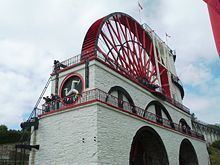Opened 1854 | ||
 | ||
Diameter 72 feet 6 inches (22.10 m) Similar Peel Castle, Castle Rushen, Snaefell, Manx Museum, House of Manannan | ||
The great laxey wheel isle of man
The Laxey Wheel (also known as Lady Isabella) is a large waterwheel built into the hillside above the village of Laxey in the Isle of Man. Designed by Robert Casement, the wheel has a 72-foot-6-inch (22.1 m) diameter, is 6 feet (1.8 m) wide and revolves at approximately three revolutions per minute.
Contents
- The great laxey wheel isle of man
- Map of Laxey Wheel Isle of Man
- Laxey wheel isle of man 2012 largest water wheel in the world
- History
- Technical details
- Dimensions
- Mine
- Musical wheel
- References
Map of Laxey Wheel, Isle of Man
Laxey wheel isle of man 2012 largest water wheel in the world
History
It was built in 1854 to pump water from the Glen Mooar part of the Great Laxey Mines industrial complex. It was named "Lady Isabella" after the wife of Lieutenant Governor Charles Hope, who was the island's governor at that time.
The 150th anniversary of the Lady Isabella was celebrated by the people of Laxey with a grand fayre on Saturday 24 September 2004. It is currently maintained by Manx National Heritage as part of the Great Laxey Wheel & Mines Trail.
The wheel features today on the reverse side of the £20 notes issued by the Isle of Man Government.
Technical details
A water-powered wheel was used because the Isle of Man does not have a supply of coal for a steam-powered pump.
Water from the surrounding area – including the local river – is collected in a cistern, which is above the level of the top of the wheel. A closed pipe connects the cistern to the top of the wheel; thus the water flows up the tower as an inverted syphon. The water falls from the pipe into the buckets (formed from wooden slats on the circumference) and makes the wheel rotate in what is described as the 'reverse' direction. The crank has a throw of 4 feet (1.2 m) and connects to a counterweight and to a very long rod. This rod runs along the rod viaduct to the pumping shaft where the 8 feet (2.4 m) stroke is converted by T-rockers into a pumping action.
Most of the wheel and rod is made of wood; however, key mechanical parts are metal to provide tension and bearing surfaces. The rod has attached wheels at intervals to permit the stroke's motion with minimal friction.
Dimensions
Mine
The mine employed over 600 miners at its peak, producing lead, copper, silver and zinc, until it closed in 1929. In 1965 the Manx Government bought the wheel and site. The wheel was restored; in 1989, it was put under the control of Manx National Heritage.
Musical wheel
The wheel has a piece of music dedicated to it: penned by the late Stuart Slack, it is entitled The Laxey Wheel.
